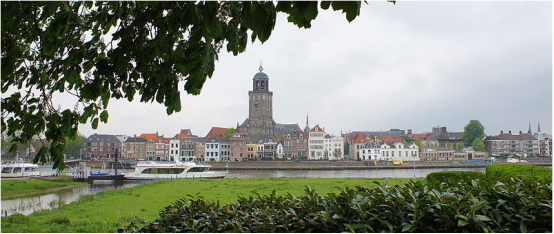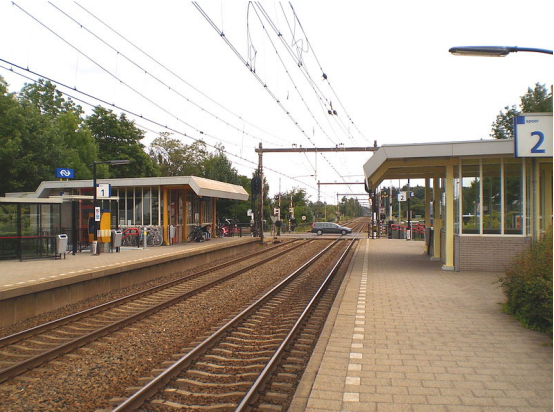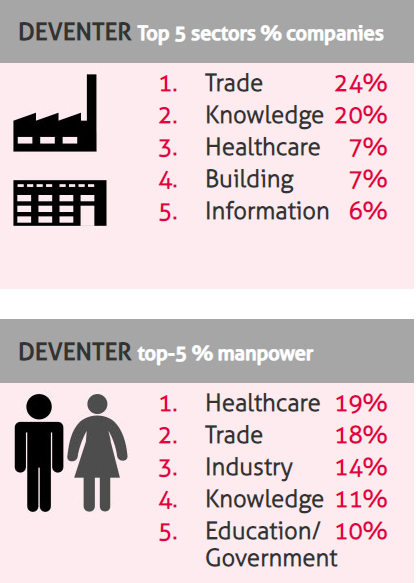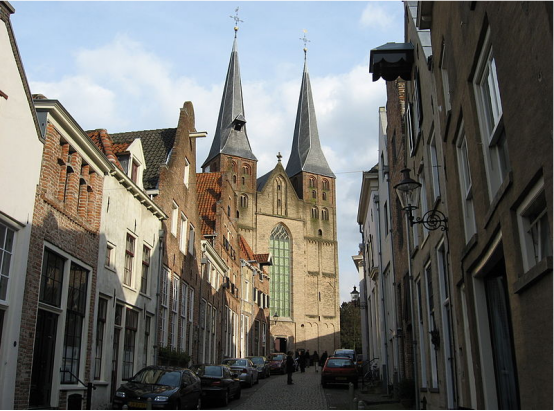Deventer,Overijssel 作者: 来源: 发布时间:2021-03-30
I.Population and Area
Country Netherlands
Province Overijssel

Government
• Body Municipal council
• Mayor Ron König (D66)
Area
• Total 134.33 km2 (51.87 sq mi)
• Land 131.23 km2 (50.67 sq mi)
• Water 3.10 km2 (1.20 sq mi)
Elevation 9 m (30 ft)
Population (January 2019)[3]
• Total 99,957
• Density 762/km2 (1,970/sq mi)
Demonym(s) Deventers
Time zone UTC+1 (CET)
• Summer (DST) UTC+2 (CEST)
Postcode
7400–7438
Area code 0570
Website www.deventer.nl
Deventer (Dutch pronunciation: [ˈdeːvəntər] (About this soundlisten); Sallaans: Daeventer) is a city and municipality in the Salland region of the province of Overijssel, Netherlands. In 2017, Deventer had a population of 99,577. The city is largely situated on the east bank of the river IJssel, but also has a small part of its territory on the west bank. In 2005 the municipality of Bathmen (with a population of about 5,000 people) was merged with Deventer as part of a national effort to reduce bureaucracy in the country.
II Geography

The population centres in the municipality are:
Deventer:
Snippeling (a small community about 2 km east of the city centre)
Colmschate (Deventer suburb quarters surrounding eponymous village 4 km east of the city centre, ice skating hall, small railway station)
De Bannink
Oxe
Diepenveen, a village 4 km to the north, surrounded by forest
Molenbelt
Rande
Tjoene
Lettele, in a forest area
Linde
Oude Molen (old mill)
Zandbelt
Okkenbroek
Schalkhaar (former centre of Diepenveen municipality including Lettele and Okkenbroek until 1999)
Averlo
Frieswijk
Bathmen (independent municipality until 2005)
Apenhuizen
Dortherhoek
Loo
Pieriksmars
Zuidloo
Transport
Deventer has 2 railway stations - for destinations see
1. Deventer Colmschate railway station

Location Deventer, Netherlands
Coordinates 52°15′01″N 6°12′55″ECoordinates: 52°15′01″N 6°12′55″E
Line(s) Deventer–Almelo railway
Location within the Netherlands
Deventer Colmschate is a railway station located in Deventer, Netherlands. The station was opened in 1888 and is located on the Deventer–Almelo railway. The train services are operated by Nederlandse Spoorwegen.
The station was closed between 15 May 1933 and 10 December 1989. Before the reopening in 1989, the station's name was simply Colmschate as Colmschate was a village back then. Some time after the closure, it was incorporated as a neighbourhood of Deventer.
In 2018, a tunnel was dug under the station by ProRail to remove the railroad crossing.
2. Deventer railway station
Location Deventer, Netherlands
Line(s) Apeldoorn–Deventer railway
Deventer–Almelo railway
Arnhem–Leeuwarden railway
History
Opened 5 August 1865
Deventer is a railway station in Deventer, Netherlands. The station was opened on 5 August 1865 and is on the Apeldoorn–Deventer railway, Deventer–Almelo railway and the Arnhem–Leeuwarden railway. The train services are operated by Nederlandse Spoorwegen.
History
In 1860 the state decided to connect the largest towns and cities in the Netherlands with each other. The railway between Arnhem, Zutphen, Deventer, Zwolle, Heerenveen and Leeuwarden was known as State railway A. When the station opened in 1865 it was connected with Arnhem and in 1861 the line to Zwolle opened.
More than 20 years later, in 1887, the railway between Apeldoorn and Deventer opened. A year later this was extended to Almelo. The Arnhem–Zwolle railway and Apeldoorn–Almelo railway were operated by competing companies which resulted in two separate stations being built.
The station was also the terminus of the OLDO, a local railway to Raalte and Ommen which opened in 1910 and closed in 1935. Around the time this line was opened, the other two railways were altered, raising them above ground level to avoid conflicts with road traffic. This is also when the combined station was built for all the railway lines. The current building dates from 1914 and the island platforms were built in 1920.
In 1892, when the line between Apeldoorn and Almelo was upgraded to a main line, it became an important east–west connection. It was decided in 1917 to add a second track on this line. Shortly afterwards the Zwolle to Zutphen line was also doubled. The lines were electrified in the 1950s. This made the station an important interchange from all directions. The station was also on the international route between the western part of the Netherlands and Germany. The Almelo-Salzbergen railway was connected with the line from Apeldoorn in 1892. This meant trains could operate from Amsterdam, Hook of Holland and Rotterdam to Germany, Scandinavia and Russia. Names of these trains included the Holland-Scandinavië Express, Nord-West Express and Hoek-Warszawa Express. The trains had carriages for destinations such as Berlin, Warsaw, Copenhagen and Moscow. From 1991 an increasing number of trains operated through to Berlin and in 1993 the final international train operated from the Hook of Holland. Today there is a train every two hours between Amsterdam and Berlin, operating via Deventer. Until December 2010, one of these trains ran to the Polish city of Szczecin.
Train services
in the 2020 timetable the following train services call at this station:
7 tpd (trains per day) express Intercity service: Amsterdam - Amersfoort - Hengelo - Osnabrück - Hanover - Berlin
1 tph (train per hour) express Intercity service: Schiphol - Amersfoort - Hengelo - Enschede
1 tph express Intercity service: The Hague - Utrecht - Amersfoort - Hengelo - Enschede
2 tph express Intercity service: Zwolle - Arnhem - Nijmegen - 's-Hertogenbosch - Roosendaal
2 tph local Sprinter service: Apeldoorn - Deventer - Almelo (- Enschede in weekday peak hours); reduced service on evenings and weekends
during peak hours additional Intercity train between Amersfoort - Apeldoorn - Deventer.
Bus services
There is a small bus station next to the station. Many town services stop there as well as regional bus services. All services are operated by Syntus.
III. Economy
Deventer: strong in tourism, information and sustainable manufacturing industry.
Deventer is strong when it comes to tourism, information & communication and a sustainable manufacturing industry. The business community and the municipality of Deventer have formulated three targets for the city’s economic future. Both the business community and the municipality are investing millions of euros in projects that will further strengthen these targeted areas.
INFO
DEVENTER HAS 3 TARGET AREAS TO WORK WITH FOR THE FUTURE
Sustainable manufacturing city
Fascinating city to live/experience
Open information city

FACTS
Retail capacity in Deventer
Total 641 Locations
- food 127
- non food 514
Of which, among others
- fashion 199
- living 61
- white and brown goods 33
- sports equipment and leisure 20
Top 5 sectors in deventer
19% Healthcare and welfare
18% Wholesale and retail
14% Industry
11% Research and consulting
10% Education and government
IV Industries Characteristics
There is a large variety of small and large businesses that call our city home. Think logistics, manufacturing or Clean Tech. Many of these companies are part of the international market. The location is perfect due to the proximity to the A1 motorway and the IJssel. For instance, the A1 Industrial park Deventer is very accessible. This location, visible from the motorway, offers many opportunities, both national and international. The easy access results in fast import and export of goods.
Logistieke verbanden
Deventer is a member of the the Holland International Distribution Council and the Vereniging voor Binnenhavens (Dutch inner harbour association).
Collaborating on export: http://www.exportdeventer.nl
Deventer is partner of Slimreizen Stedendriehoek (smart travelling city-triangle)

Shopping city
Let yourself be surprised by the unique boutiques in the city centre and the convenience of large multiple store chains within walking distance from each other. The wide variety of shops is the main attraction in the heart of the city. Deventer, the most enjoyable city for shopping in the east.
3+top engineeringfirms:
Akzo lab
Ardagh cans
Krehalon seal tech
V. Sights
The Waag (Weighing-house) on the edge of the Brink square, built in 1550 and restored in 2003. The Deventer City Museum is housed inside the Waag. The Museum's collections include industrial and trading history, paintings by Gerard Terborch and Han van Meegeren, silver objects, and prehistoric findings). Thea Beckman's novel Het wonder van Frieswijck ("The Frieswijck Miracle") features the Waag.

On the outer wall of the Waag hangs a large kettle that is over 500 years old, said to have been used for a public execution in the late Middle Ages; a man who had produced counterfeit coins was cooked to death in it. According to local tradition, there are holes in the kettle shot by footmen of Napoleon's army around 1809.
The Saint Lebuïnuskerk (St. Lebuin's Church) in Gothic style, with ceiling paintings and an organ. Its tower can be climbed in summer.
The Brink (market square) with houses, shops, and cafes dating from 1575–1900. The market square is also the centre of Deventer nightlife. Alongside this square there is the Bussink "Koekhuisje", where you can buy Deventer Koek (honey-cake).[tone] Markets take place every Friday (including one on Good Friday, following a medieval tradition) and Saturday.
The Speelgoedmuseum (Toy Museum) behind the Waag, housed in an old house in the city
The medieval Bergkerk (Mountain Church), on top of a small hill (old river dune), now a museum for modern art.
The old streets around the Bergkerk, known as Bergkwartier (Mountain Quarter) situated on and around an old river dune.
The Stadsarchief en Athenaeumbibliotheek (City Archive and Athenaeum Library), the oldest scientific library of the Netherlands (founded in 1560).
De Proosdij in the Sandrasteeg is the oldest stone house of the Netherlands still in use. The earliest parts dating back to around 1130.
VI History
Foundation and development in the Middle Ages
Deventer was probably founded around AD 768 by the English missionary Lebuinus, who built a wooden church on the east bank of the river IJssel. In January 772 the sack and burning of this church by a Saxon expedition was the cause for the first punitive war waged by Charlemagne to the Saxons, in which, in retribution, the Irminsul (the Saxon sacred tree, probably near modern Paderborn) was destroyed. This was not the first human settlement at the location; between 1981 and 2006, remains of a Bronze Age settlement (dated to c.400 AD) were excavated at Colmschate, 4 km east of the current city
The towers of the St. Nicholas Church date back to circa 1200
The village of Deventer, already important because of a trading road crossing the river IJssel, was looted and burnt down by the Vikings in 882. It was immediately rebuilt and fortified with an earthen wall (in the street Stenen Wal remains of this wall have been excavated and restored).
Deventer received city rights in 956, after which fortifications were built or replaced by stone walls around the city for defense. Between 1000 and 1500, Deventer grew to be a flourishing trade city because of its harbour on the river IJssel, which was capable of accommodating large ships. The city eventually joined the Hanseatic League.
One of the commodities it traded in, dried haddock and cod from Norway, gave the citizens the nickname they carry to this day: "Deventer Stokvis" In the 15th century, Deventer had a common mint, where coins for the three IJssel cities Deventer, Zwolle, and Kampen were made.
Deventer is the birthplace of Geert Groote and home to his Brethren of the Common Life, a school of religious thought that influenced Thomas a Kempis and Erasmus in later times. Together with Haarlem it was among the first cities to have printing presses, dating back to as early as 1477. From around 1300, it also housed a Latin School, which became internationally renowned, and remained in service in changing forms until 1971. Its most well-known was the scholar Desiderius Erasmus, who was born in 1466 and attended the school from 1475 to 1484.
16th–18th centuries

1652 map of Deventer by Willem and Joan Blaeu
Between 1500 and 1800, the volume of water flowing through the IJssel decreased, decreasing the importance of Deventer's harbour. The competition with trade centres in Holland, as well as the religious war between 1568 and 1648, brought a decline in the city's economy.
In the 18th century, the iron industry came to Deventer. East of the town, so-called "oer", riversand containing iron, was found as early as 900. From this material, ore was produced and brought to town. The main road of the villages Okkenbroek, Lettele and Schalkhaar is still named Oerdijk (Ore Dyke).
Modern times
In the 19th century, Deventer became an industrial town. Bicycles (Burgers), carpets (Koninklijke Deventer Tapijtfabriek), tins and cans for food and drinks (Thomassen & Drijver), cigars (Horst & Maas en Bijdendijk & Ten Hove), foundry and heavy machinery (Nering Bögel), and textiles (Ankersmit)[4] were produced until the mid to late 20th century. Some of these industries are still thriving today, such as beds and accessories (Auping) and publishing (Wolters Kluwer, now headquartered in Alphen aan den Rijn)
The city's trade and industry is still of some importance. The city is host to a factory producing central heating systems, as well as Wolters Kluwer, a global information services and publishing company.
The Deventer honey cake (Bussink Deventer Koek), produced in Deventer for over 500 years, is still manufactured locally and sold all over the Netherlands and beyond.
World War II
Shooting a scene from A Bridge Too Far on location in Deventer, 1977
Deventer has seen few military engagements throughout its long history, although it was a garrison city of the Dutch cavalry. The industrial area and harbour were bombed heavily during World War II. The city centre has been largely spared, thus offering a view that has remained largely unchanged for the past few centuries.
The female Jewish poet and writer Etty Hillesum lived in Deventer during the war before being deported to Auschwitz.
In Schalkhaar, a village only 2 km northeast of the city centre, barracks were used by the German occupying forces to train Nazi policemen. The compound is now a centre for asylum seekers.
Deventer has been somewhat popular with the film industry. During the production of the 1977 film A Bridge Too Far, all of the scenes taking place in nearby Arnhem were filmed in Deventer - as Arnhem itself had lost its historic centre.
VII. Historical city
Deventer is one of the oldest cities in the Netherlands. Around the year 800 there was already an urban settlement on the river IJssel. In the Middle Ages, the settlement grew into a full-fledged city. Its location on the IJssel made it possible for the city to develop into an important trading center. As a prominent member of the medieval trade alliance Hanseatic the city experienced in the 14 e and 15 e century, its "golden years". Every year the city had six annual fairs, where merchants from all over Europe came to the IJsselstad.
14 E and 15 E century, the city brought a great prosperity, and not only economically. During this period, the religious movement the Modern Devotion also arose, led by Geert Grote. The Latin School was a renowned educational institution. After the 15 e century Deventer has remained a true city, although of lesser fame than before, but still always a prominent settlement at the IJssel.
What is special about Deventer is that much of its rich history has been preserved. Few cities in the Netherlands can display as many monuments as Deventer. In addition, almost all the monuments in the city have been restored over the past thirty years. The monumental Bergkwartier is a good example of this.
Sports
Deventer is the home of professional Football club Go Ahead Eagles, who are housed in stadium De Adelaarshorst. De Adelaarshorst is situated in a 1930s neighbourhood and one of the oldest stadiums still in use today.[citation needed] The club was founded in 1902 as Be Quick, although the name was soon changed to Go Ahead at the request of the Dutch Football Association. The suffix Eagles was added in 1971, following a suggestion from the then coach, Barry Hughes. Go Ahead Eagles has been the club of Marc Overmars, Paul Bosvelt, and Bert van Marwijk, whilst providing Henk ten Cate and Leo Beenhakker with their first experience of management.
The 1992 founded skating rink De Scheg, which is semi-indoor since 2011, is in the top 10 of fastest skating tracks of the Netherlands. It has been the training accommodation of skaters including Olympic champion Mark Tuitert and the retired former world champion sprint Erben Wennemars.
Deventer also houses a number of watersports clubs, due to its situation on the banks of the river IJssel.
Events and festivals
In the first weekend of July, the city centre is the scene of the open air festival "Deventer op stelten" (Deventer on Stilts). Actors and artists give free performances in the streets and on the Brink square. All actors must use stilts during their acts.
In August, Deventer is home to Europe's largest book fair, attracting 125,000 visitors.
The Dickens Festival in December sees some of the oldest streets and alleys in the city dressed up in the style of the Victorian era. In 2018, the festival attracted 125,000 visitors.
VIII. Contact Information
Mayor Ron König

Born: October 14, 1964 (age 55 years), Doesburg, Netherlands
Education: University of Amsterdam
Twitter Ron König
@ronkonig
Telephone 14 0570
phone number +31 570 69 39 11
WhatsApp: +31 6 83 54 25 52.
email address n.mitut@deventer.nl
https://www.deventer.nl/english
Twitter Gemeente Deventer
@DeventerGem
Facebook: Gemeente Deventer
@GemeenteDeventer
Youtube DeventerStad
